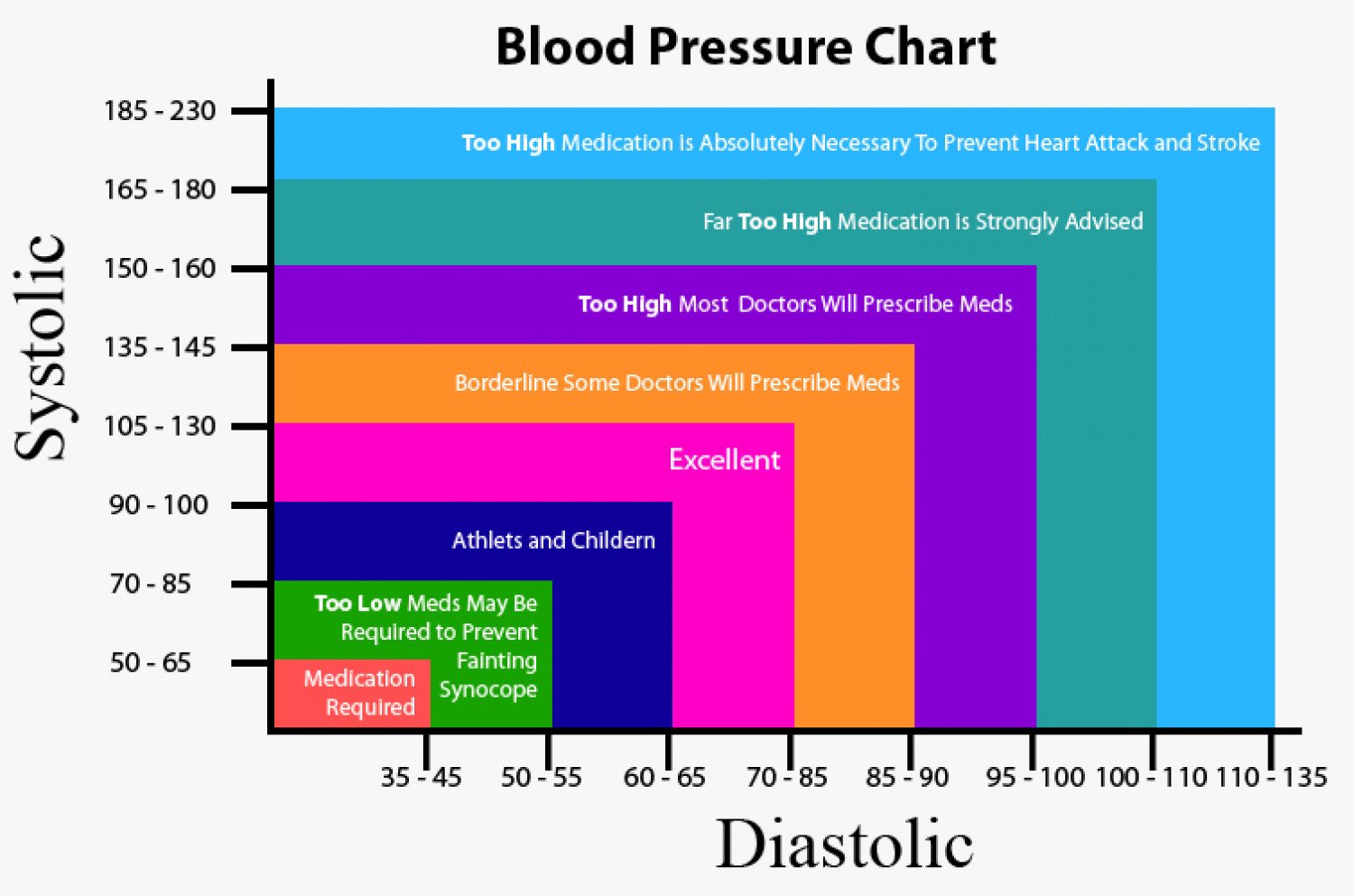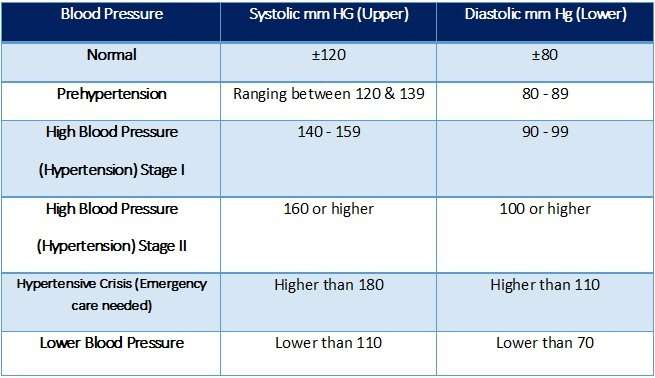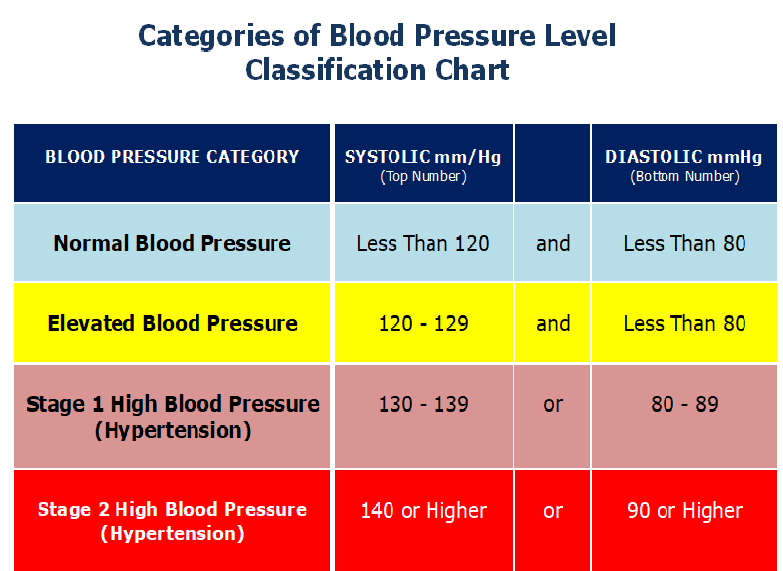About Low Blood Pressure
The heart pumps a constant supply of blood around the body. The blood flows through different networks in the body, for example, arteries, veins and capillaries. Blood pressure is a measure of the force of the blood on the walls of the arteries as the blood flows through them.
It’s measured in millimetres of mercury and recorded as two measurements:
- systolic pressure the pressure when your heart beats and squeezes blood into your arteries
- diastolic pressure the pressure when your heart rests between beats
For example, if your systolic blood pressure is 120mmHg and your diastolic blood pressure is 80mmHg, your blood pressure is 120 over 80, which is commonly written as 120/80.
Normal blood pressure is between 90/60 and 140/90. If you have a sustained reading of 140/90 or more, you have high blood pressure . This puts you at greater risk of developing serious health conditions, such as heart attack or stroke.
People with a blood pressure reading under 90/60 are usually regarded as having low blood pressure.
How Does Blood Pressure Work
During relaxation of the heart , the left ventricle of the heart fills with blood returning from the lungs. The left ventricle then contracts and pumps blood into the arteries . The blood pressure in the arteries during contraction of the ventricle is higher because blood is being actively ejected into the arteries. It is lower during relaxation of the ventricle when no blood is being ejected into the arteries. The pulse we feel when we place our fingers over an artery is caused by the contraction of the left ventricle and the ejection of blood.
Blood pressure is determined by two factors:
Generally, blood pressure tends to be higher if more blood is pumped into the arteries or if the arterioles are narrow and/or stiff. Narrow and/or stiff arterioles, by resisting the flow of blood, increase blood pressure. Arterioles may become narrower when the muscles surrounding them contract. Arterioles may become stiff and narrow when older patients develop atherosclerosis.
Blood pressure tends to be lower if less blood is being pumped into the arteries or if the arterioles are larger and more flexible and, therefore, have less resistance to the flow of blood.
The heart rate increases and the forcefulness of the heart’s contractions increase, pumping more blood through the heart.
When To Worry About Low Blood Pressure
We all know that high blood pressure can be dangerous. But what about low blood pressure
Also called hypotension, low blood pressure is not a problem if youre healthy and show no signs or symptoms of the condition. However, abnormally low blood pressure can cause problems such as dizziness and fainting and can be a sign that other serious conditions, such as heart disease, are present.
Read Also: Does Vinegar Lower High Blood Pressure
What Is The Ideal Blood Pressure
Blood pressure readings are calculated using one number over another: systolic blood pressure over diastolic. The blood pressure monitor shows measurements in millimetres of mercury, appearing as mmHg. Everyones blood pressure will be slightly different and you would need to discuss with a medical professional as to whats safe for you.
The normal blood pressure range for adults comes in between 90/60mmHg and 120/80mmHg. This means that anything below 90/60mmHg mark constitutes low blood pressure , while anything above 140/90mmHg indicates high blood pressure as this is the threshold where a medical professional would actively monitor your blood pressure.
Knowing these numbers can help make you more aware of your health, and may help you to stay on top of your blood pressure
Read Also: Will Aspirin Raise Blood Pressure
Low Blood Pressure Definition And Facts

- Low blood pressure, also called hypotension, is blood pressure low enough that the flow of blood to the organs of the body is inadequate and symptoms and/or signs of low blood flow develop.
- Low pressure alone, without symptoms or signs, usually is not unhealthy.
- The symptoms of low blood pressure include lightheadedness, dizziness, and fainting. These symptoms are most prominent when individuals go from the lying or sitting position to the standing position .
- Low blood pressure that causes an inadequate flow of blood to the body’s organs can cause strokes, heart attacks, and kidney failure. The most severe form is shock.
- Common causes of low blood pressure include a reduced volume of blood, heart disease, and medications.
- The cause of low blood pressure can be determined with blood tests, radiologic studies, and cardiac testing to look for heart failure and arrhythmias.
- Treatment of low blood pressure is determined by the cause of the low pressure.
Read Also: How Does Alcohol Increase Blood Pressure Mechanism
Diagnosis Of Low Blood Pressure
Your GP will ask about your symptoms and examine you. Theyll measure your blood pressure using either an automated digital device or a manual device. To find out more about how blood pressure is measured, see our animation at the top of this page, Having your blood pressure taken, in the introduction above.
If you have symptoms of postural hypotension , your GP may also measure the change in your blood pressure while youre sitting and then standing. If its much lower when you stand up compared with when youre sitting down, this suggests you have postural hypotension.
Your GP may also recommend that you have some blood tests to check your general health and an electrocardiogram to check the electrical activity of your heart. They may also ask you to have an echocardiogram if they need to check for any underlying problems affecting your heart.
If your symptoms need further investigation, your doctor may recommend that you have a tilt test. The test involves being slowly tilted from lying down to an upright position on a table as your blood pressure, heart rate and rhythm are monitored. For more information, see our FAQ: What happens in a tilt test? below.
Postural Or Orthostatic Hypotension
Postural or orthostatic hypotension occurs when your blood pressure falls after a sudden movement. For example, you may feel dizzy or faint after changing posture, such as sitting up from a lying position, or standing up from a sitting position. This may cause you to lose your balance and fall over. You may also feel light-headed, have blurred vision, or lose consciousness.
The symptoms of postural or orthostatic hypotension should only last a few minutes as your blood pressure adjusts to your new position. This type of low blood pressure tends to affect people more as they get older when it can lead to more frequent falls. Similar symptoms may also occur after exercise.
Also Check: Calibrating Omron Blood Pressure Monitor
Digital Blood Pressure Monitors
Digital blood pressure monitors are often used on the wrist, but they can also be placed on the finger or upper arm and are activated simply by pressing a button. They read the blood pressure automatically based on variations in the volume of blood in the arteries. When taking blood pressure measurements on the wrist, it’s important to keep the hand level with the heart. Otherwise it can affect the readings.
Digital meters can sometimes be inaccurate and produce unreliable readings anyway especially in people with certain heart rhythm problems or arteries that have hardened due to arteriosclerosis.
Objective Signs Of Low Blood Pressure / Hypotension
The best objective symptom of a low blood pressure is taking an actual pressure and getting low numbers. It sounds obvious, but it may not occur to you to take a pressure when a patient complains of certain symptoms.
When a patient does complain, however, it is usually recommended that you get a complete set of vitals, and this will point to a problem with low blood pressure. How low is too low? What does low actually mean? It can mean different things for different patients.
The usual metric for measuring low blood pressure is that anything below 90/60 mmHg is considered low enough to treat. You can also have symptoms of low blood pressure when someone with hypertension comes down from very high pressures. For instance, 120/80 mmHg may be normal for everyone else, but if your patient lives at 190/100 mmHg, they are going to feel the difference. For this reason, the objective sign of a pressure must be combined with the subjective symptoms the patient reports.
Also Check: Does Claritin D Raise Blood Pressure
Diagnosis Of Hypertension And Hypotension`
Hypertension and hypotension both can lead to several fatal diseases. Physicians take two or three blood pressure readings each at three or more separate appointments before diagnosing a person with high blood pressure. To confirm if one has hypertension the physician mayrecommend a whole day long monitoring test called ambulatory blood pressure monitoring. One may also be recommended to undergo some routine tests like a urine test, a cholesterol test, an electrocardiogram, and an echocardiogram also to check for more signs of heart disease.
Continuous changes in lifestyle can control hypertension. The changes are as follows:
-
Eating a heart-healthy less salty diet
-
Regular physical exercise
-
Maintain proper weight
-
Restricting the amount of tobacco and alcohol
In addition to these lifestyle changes, one has to take medication if it has been prescribed by the doctor.
Hypotension may also turn into a disaster if medical assistance is not taken in time. Some regular blood tests, echocardiogram , and Tilt table test can tell if you have low blood pressure or not. The treatment of Hypotension depends on the very cause. According to the patients age, health and the type of hypotension he/she has, one can apply any one of these:
-
Using more salt in the diet
-
Drinking plenty of water
-
Take medications as prescribed by the physician
Causes Of Low Blood Pressure
Your blood pressure can vary depending on the time of day. It gradually increases throughout the day.
What you’re doing and how you’re feeling can also affect it.
There are many possible causes of low blood pressure. It may be low because you’re fit and healthy, or you may have inherited it from your parents.
Some people develop low blood pressure as they get older.
It can also be caused by:
- being pregnant
Read Also: High Blood Pressure Mayo
How Blood Pressure Is Measured And What The Readings Mean
Blood pressure is expressed as two numbers, with one over the other. The first, or top, number is the systolic blood pressure. This indicates the amount of pressure your blood exerts against the walls of your arteries when your heart contracts. The second, or bottom, number is the diastolic pressure, which refers to the amount of pressure in your arteries when your heart refills between beats.
Your healthcare provider typically measures your blood pressure using a stethoscope and an inflatable cuff that wraps around your upper arm. The cuff is inflated until it is tight enough to stop the blood from flowing, then it is slowly deflated. Through the stethoscope, your doctor or nurse will hear the whooshing sound of the blood returning this is the systolic pressure. The moment the whooshing sound disappears marks the diastolic pressure.
The commonly accepted ideal blood pressure for adults is 120/80 mm Hg or lower. But since blood pressure naturally rises with age, your BP might be higher than that without any cause for concern. For instance, according to a chart from Disabled World, a normal blood pressure reading for an 80-year-old woman could be 134/84 mm Hg.
So, what is considered low blood pressure in elderly people? Typically, the low blood pressure range is anything below 90/60 mm Hg. This is called hypotension. The Disabled World chart shows that a dangerous blood pressure level is 50/33 mm Hg.
Low Blood Pressure Symptoms

Low blood pressure is pressure so low it causes symptoms or signs due to the low flow of blood through the arteries and veins. When the flow of blood is too low to deliver enough oxygen and nutrients to vital organs such as the brain, heart, and kidney, the organs do not function normally and may be temporarily or permanently damaged.
Unlike high blood pressure, low blood pressure is defined primarily by signs and symptoms of low blood flow and not by a specific blood pressure number. Some individuals routinely may have blood pressure numbers of 90/50 with no symptoms and therefore do not have low blood pressure. However, others who normally have higher blood pressures may develop symptoms of low blood pressure if their blood pressure drops to 100/60.
During pregnancy, blood pressure tends to decrease. Normal blood pressure during pregnancy may be lower than 100/60. Your OB/GYN or Midwife should monitor your bood pressure if you are pregnant.
You May Like: Can I Take Claritin If I Have High Blood Pressure
Drink Plenty Of Water
Dehydration can sometimes lead to low blood pressure. Some people may have hypotension even with mild dehydration.
You can also get dehydrated by losing water too quickly. This can happen through vomiting, severe diarrhea, fever, strenuous exercise, and excess sweating.
Medications such as diuretics may also cause dehydration. Drink more water by using a portable water bottle. Use an alarm or timer to remind you to take a sip.
If You Notice A Sudden Decline In Blood Pressure
A single lower-than-normal reading is not cause for alarm, unless you are experiencing any other symptoms or problems. If you experience any dizziness, lightheadedness, nausea or other symptoms, its a good idea to consult with your healthcare provider. To help with your diagnosis, keep a record of your symptoms and activities at the time they occurred.
Is low blood pressure related to low heart rate? Find out.
Written by American Heart Association editorial staff and reviewed by science and medicine advisers. See our editorial policies and staff.
Last Reviewed: Oct 31, 2016
Also Check: Does Claritin D Raise Blood Pressure
Managing Low Blood Pressure
Having low blood pressure once in a while isnt likely a cause for concern.
Tell your doctor about any related symptoms. Keep a journal of your symptoms and what you were doing when they began.
This can help your doctor diagnose the cause of your low blood pressure, especially if youve tried making changes to your diet and lifestyle and still arent seeing your BP at a healthy level.
What Low Blood Pressure Means
Hypotension is the medical term for low blood pressure, which is typically defined by a blood pressure reading of 90/60 mm Hg or lower. For reference, a normal blood pressure range is around 100/60 mm Hg to 120/80 mm Hg.
Low blood pressure with no symptoms is rarely a cause for concern, says Nicole Weinberg, MD, a cardiologist at Providence Saint John’s Health Center. In fact, some people have chronic low blood pressure, but feel fine, and do not need to be treated.
However, if low blood pressure is combined with symptoms of dizziness, fainting, shortness of breath, or lightheadedness, it could be a sign that you need medical attention.
You May Like: Best Medicine To Lower Blood Pressure
When To See The Doctor
If you have had episodes where you feel faint or have fainted, see your doctor. In many cases, an episode of low blood pressure is nothing to worry about, but some people may have an underlying problem that needs treatment.
Treating low blood pressure will help reduce symptoms and lower the chances of you fainting or falling and injuring yourself.
What Are The Treatments For Low Blood Pressure
The treatments for low blood pressure depend on what caused the condition. Your doctor will work with you to address the cause of the hypotension. In severe cases of hypotension, your doctor may give you IV fluids to raise your blood pressure.
Depending on a variety of factors, such as your age and the type of hypotension, your doctor may recommend one or more of the following: dietary changes, lifestyle changes and/or medications.
To make dietary changes, your doctor might tell you to:
- Stay hydrated by drinking more water throughout the day.
- Drink less alcohol.
- Increase your salt intake slightly because sodium raises blood pressure.
- Eat smaller, healthy meals and limit carbohydrates.
You can take several steps to avoid a sudden drop in blood pressure. Your doctor may recommend that you make the following lifestyle changes:
- Wear compression stockings.
- Get up slowly after youve been sitting or lying down.
- Avoid standing for long periods of time.
- Sit up and breathe deeply for a few minutes before getting out of bed.
Your doctor might prescribe medications like:
- Fludrocortisone, which increases blood volume.
- Midodrine, which increases blood pressure.
You May Like: Prevention Of Low Blood Pressure
When To See Your Gp
You should see your GP if you have frequent symptoms of low blood pressure. Your GP can measure your blood pressure and help identify any underlying causes of the problem.
All adults should have their blood pressure checked at least every five years. If you haven’t had yours measured or don’t know what your reading is, ask your practice nurse or GP to check it.
What Is A Hypertensive Crisis

A hypertensive crisis occurs when blood pressure suddenly rises above 180 systolic and/or 120 diastolic. This prompt either a hypertensive urgency or hypertensive emergency.
A hypertensive urgency accounts for about 75% of hypertensive crises. In these cases, a person has high blood pressure, but without any serious accompanying symptoms. A hypertensive emergency requires immediate medical care, as high BP is accompanied by one or more serious symptoms, including:
- Acute pulmonary edema
Read Also: Can Apple Watch Tell Your Blood Pressure